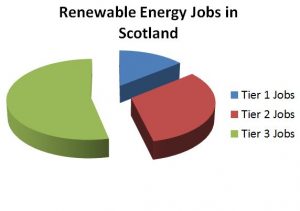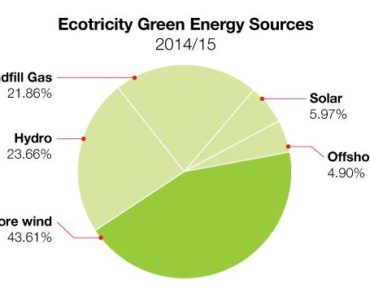One of the criticisms leveled against Renewables is the lack of local jobs created. There is a perception that since many of the firms in this sector are foreign, they bring their own workforce with them. It is said that on paper the employment figures might look rosy but in reality they are rather thorny. So albeit a growing industry, it does not benefit Scottish economy as much. If this claim is weighed on merit, one finds that there is some element of truth about it, but the picture does not represent the whole landscape.
This article aims to uncover the trends and the nature of the jobs arising in the Renewable energy industry in Scotland. The corresponding skills gap and education opportunities have also been highlighted. The article is limited to the “technical domain” i.e. only technical jobs and skills have been explored. Areas that are peripheral or supplementary such as Renewable law, finance, administration or communication have been discounted.
Jobs in the renewable industry in UK have seen a definite growth in the past five years. Earlier this year, an increase of 5% in the Renewable workforce in Scotland was reported by “Scottish Renewables”. To better understand this growth, jobs have been divided into three categories based on the skill set required and the salary drawn.
High End (Tier-1):
These jobs require a higher level of education or experience. They either require specialization in a particular field or ability to engage and deal with a broad range of disciplines. These jobs are limited and can attract applicants with higher relocation mobility due to higher pay package.
Medium Range (Tier-2):
Many jobs at this level are occupied by university graduates who have completed an Engineering degree (Civil, Mechanical or Electrical). There are more jobs at this level than Tier-1 and most require a minimum two-year industrial experience. These job roles mainly involve the design phase of renewable energy systems. In Scotland, the number of SME’s providing consultancy services in renewables is relatively high and such jobs therefore are a notable portion of the total.
Entry Level (Tier-3):
Tier-3 are the entry level jobs in the industry and most of them require skills that are applied, hands on and practical. CAD Technicians, Wind Turbine Technicians, Maintenance Engineers, Groundworkers and Sales Technicians are just a few positions to cite. Relocation mobility is low due to low pay scales and these jobs are likely to be occupied by individuals who live locally.
Based on the survey conducted by O’Herlihy and Co Ltd for Scottish Renewables1, the following data has been extrapolated.
| Tier -1 (High End Jobs) | Tier-2 (Mid-Range) | Tier-3 (Entry level Jobs) | |
| Salary Range | 45K + | 30K-45K | 16K-30K |
| Positions | Senior Consultant,Senior Project Manager, Senior Executive | Design Engineers, Project managers, Environmental Consultant, Simulation Engineer | CAD Technicians, Wind Turbine Technicians, Maintenance Engineers, Surveyors, Ground work staff, Sales Technicians |
| Requirement (%) | 14.2% | 32.2% | 53.6% |
Going back to the criticism on the value of Renewable jobs to the local economy, it must be realized that wind energy industry is older and more mature in places like Germany, Scandinavia and USA (where it has survived fluctuating policies). The UK wind industry is growing rapidly but it has been a late bloomer despite having better quality wind resources. In Europe, it trails behind even Spain when the total installed capacity is compared. Thus when the wind industry picked up in the UK, it was natural that expertise and skills were imported and positions were occupied by personal from regions where the industry was approaching a saturation phase. Recruitment agencies confirm that most of these job positions were Tier -1 cadre, while Tier-3 jobs did indeed benefit the local economy and that too in the most deprived areas ( as reported by WWF2).
The table above also shows that a greater craving exists in the industry for graduate engineers (32.2%) and budding technicians (53.6%). This is an exciting prospect for educational institutes where new crop of technical workforce is being prepared.
A report by NREL suggests3 that wind farms may produce between 0.4 and 1.4 jobs per MW (Mega Watts) of capacity during construction phase and 0.06 to 0.2 jobs per MW for operation and maintenance. Going by these figures it is clear that most of the Scottish jobs in future will come in the offshore wind sector with 1032.58 MW capacity under construction and 4594.25 MW already consented4. The Scottish Government quoted, “The offshore renewables industry is to deliver 28,000 jobs by 2020, contributing £7.1 billion to the Scottish economy.” After a-political scrutiny, even if half of these jobs are realized, it still amounts to a significant number. As most of the jobs would be in the lower tier, relevant skills would have to be provided. The higher education sector particularly colleges can play a vital role in providing skilled worked force by offering specialized courses. For example, short safety courses such as “working at heights”, “offshore survival course” and many others can be made part of the existing curriculum as most energy companies find this knowledge desirable.
Due to its sheer size, there is a tendency of emphasizing too much on just the wind industry when looking at the renewable spectrum. With the government’s plan to have smart meters installed in every household by 2020, several jobs in this area will be created of which the education institutes must take a note. A complete grid infrastructure overhaul may not be on the horizon just now but is a distinct possibility which will create huge number of jobs in Electrical Engineering. Furthermore, a catalogue of botched jobs for both Solar installations and heat pumps indicate that there is a dire need of highly trained technicians that can expertly deal with them. It is also becoming apparent that wave and tidal projects are on the verge of commercialization. Renewable UK’s studies show the sector already employs 1,724 people in the UK – this is set to increase to 6,000 by 2023. It is further anticipated that “Cap and Trade” global market (Emissions Trading) will balloon to a size of $3.1 trillion dollars by 2020 thus opening up great opportunity for carbon accountancy training.
Before 2008, undergraduate studies purely in renewable energy barely existed in the UK (neither in universities nor in colleges). Only Master’s degree in some universities offered a route to this sector. Since then the academia has gathered momentum and now offers enrolment for renewable energy technology courses from NC-level. At least three universities in Scotland currently are offering undergraduate studies in Renewable Energy Technology (RET). This number is higher at college level where many colleges have tailored and contextualized existing Environmental, Energy and Engineering Systems courses to incorporate RET. There is still a hesitance in developing a course/degree that purely focuses on Renewable energy despite it becoming a discipline in its own right. This tentative stance stems from accreditation issues and the reluctance of the industry that has traditionally accepted civil, mechanical and electrical engineers, to accept renewable engineers.
While the large commercial organizations (e.g. utility companies) prefer the recruitment of novice students/ young apprentices to train them in-house, data reveals that in Scotland most organizations are small–medium scale with average number employees just “9”. This means that there is a greater responsibility on the educational institutes to provide the relevant workforce.
With Scotland taking on the most ambitious carbon reduction targets and being a pioneer in technologies such as Wave Power, it has the potential to become world’s “Centre of Excellence” in Renewable energy education. By widening its education sector to charter the changing needs, it can be not only cater to its own industry but in future export tier-1 expertise to a flourishing global market. Just as in the 90’s the academia benefitted and grew by imparting the IT (information technology) education, similar benefits can be reaped from renewable education. For sustainable growth however, it is imperative that the fast-moving industry is kept in sight. It must be realized that although in the near future jobs may lie in the offshore wind industry but further afield, wave, tidal and grid technologies are emerging must be made prepared for. Furthermore, the education sector also has to keep a close eye on the pyramid structure of skill requirements so that focus and energy is spent in areas where it is most needed.
References:
- Larry Flowers and Marguerite Kelly, “Wind Energy for Rural Economic Development,” National Renewable Energy Laboratory, Presented 2005,
- “Renewable UK” Wind Energy database (3rd June 2014)







